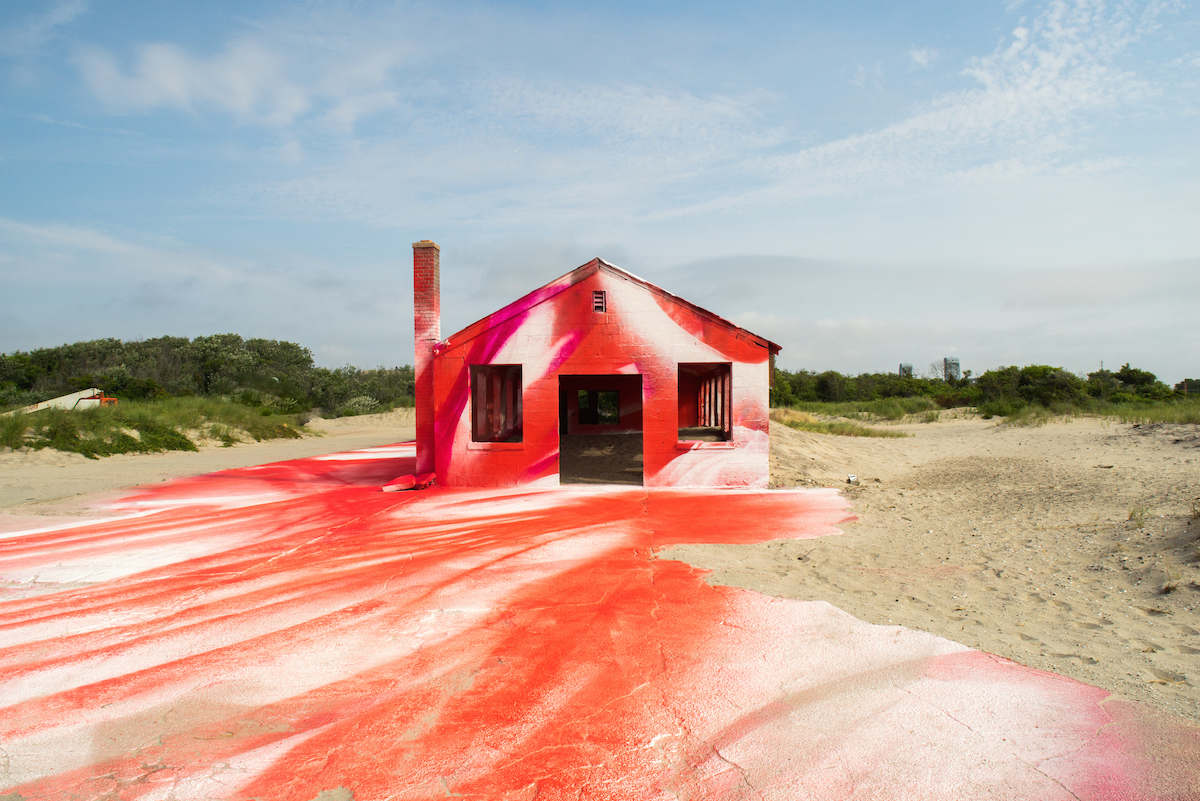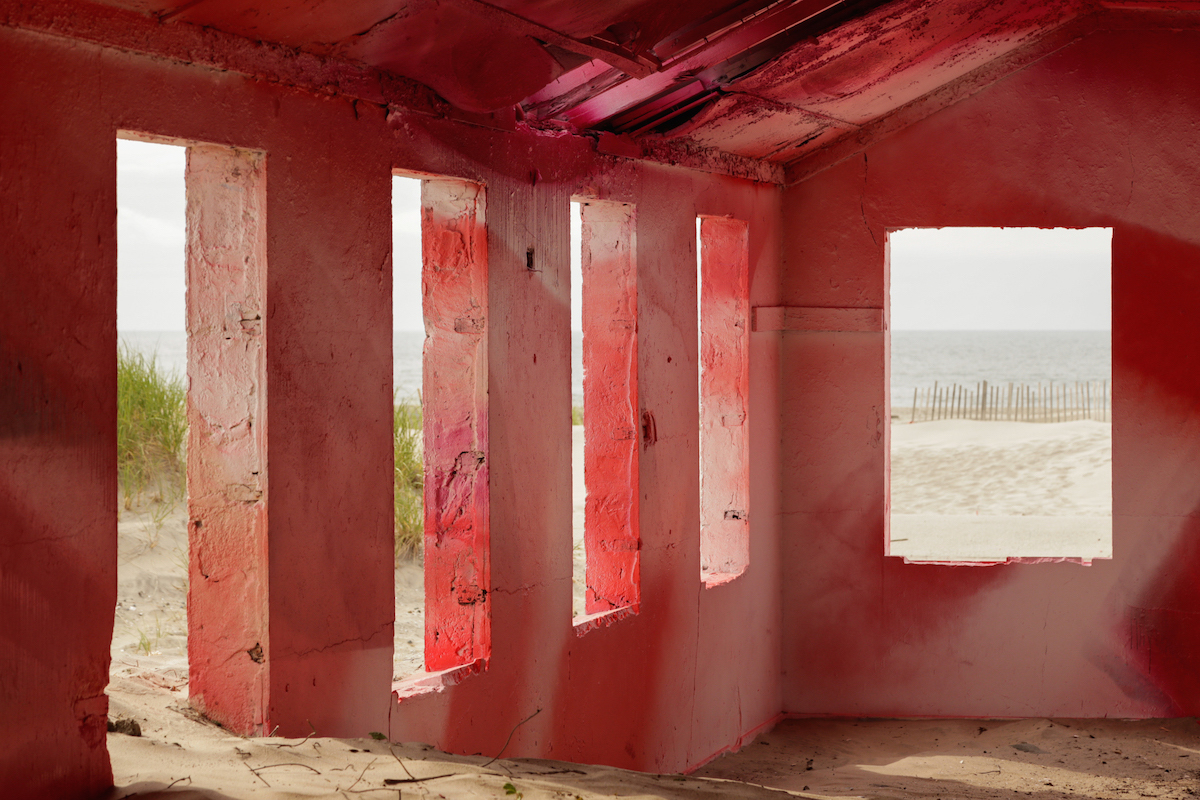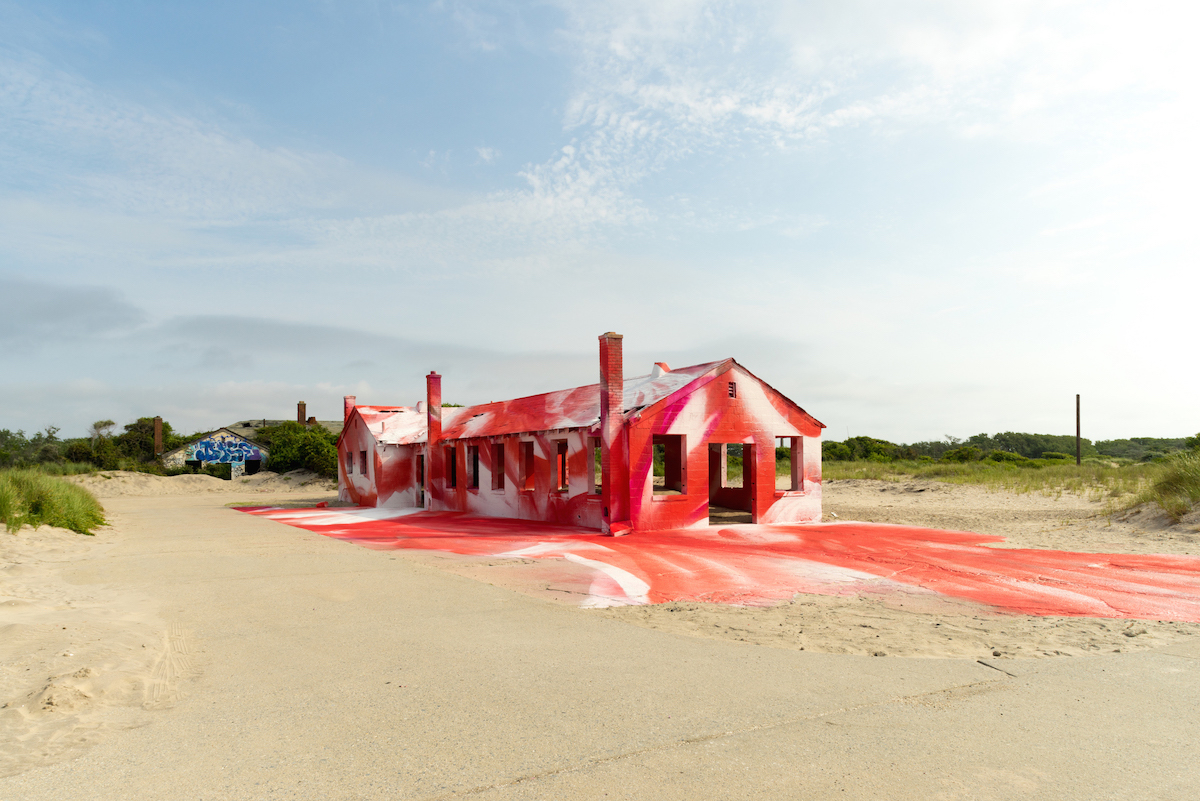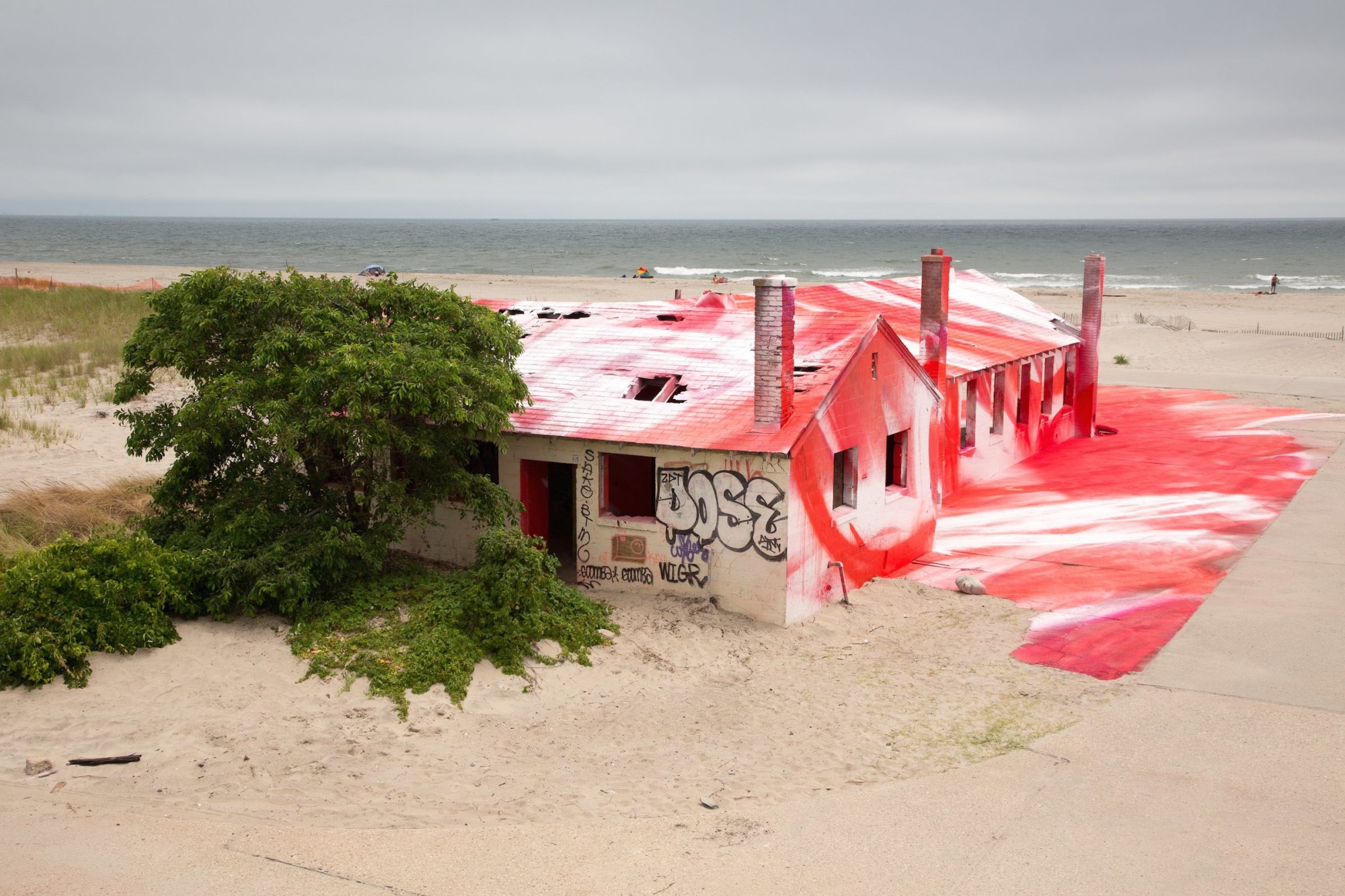On a humid, overcast day in The Rockaways stand two chic Germans on a resilient stretch of NYC beach still scarred from Hurricane Sandy. MoMA PS1 director Klaus Biesenbach and Berlin artist Katharina Grosse have for the last few months been devising a send-off for one of the beach’s most iconic buildings, and Biesenbach’s favorite: the former aquatics, built back when Fort Tilden was a military base. The decaying brick skeleton is now the canvas for a resplendent wash of colors reflecting a patriotic, candy cane sunset. It’s the local icon’s last hurrah before the building is finally demolished to make room for protective dunes and the restoration of the natural beachfront. “This is not saying goodbye,” Biesenbach reminds us, “this is a big greeting to the future.”
The perennially sharp-suited curator has assumed a second position as The Rockaways’ unofficial mayor. In 2014 he and Patti Smith organized a low-key beachside poetry reading that ended up drawing a horde of thousands. This time, he wanted to create something that visitors — not just the ones constituting his 200k Instagram followers and Smith’s innumerable number of citywide fans — could filter through at their own leisure. And after a trip to a still-ravaged New Orleans in 2008, three years after the devastating Hurricane Katrina, he knew just the artist to help create his vision. “There was this one project that really stuck with me, and I was really deeply moved,” he says of visiting for the city’s Prospect.1 Biennial art show. “It was Katharina Grosse’s building in the Lower Ninth Ward, where she had applied golden yellow colors, and she gave this abandoned, condemned building such a temporary glow and beauty. This project stuck with me, and that was the image I carried away after Katrina.” On the bus ride back from the beach, through Brooklyn, and back to the city, we spoke to the Berlin-based artist about the beauty of ephemerality and becoming immersed in the close-knit beach community.

How did you come to work with Klaus, and how did this project come about?
Klaus approached me. Klaus knew my work, and I know what he is doing. I think he had that very spot in mind, and saw the potential of my work doing something to it. I think he investigated a little more into my work, and sent me some photographs. I looked at it from my perspective, and we were building models with very exact measures. At the beginning we were thinking we would use all the three houses that are there. I made proposals, and the parks people had a say in it — they had to approve of all plans, and my plans had to change and adapt a little. It maybe happened in five weeks or so.
Being from a big city in Germany, what was your perception of The Rockaways before you came out here?
I didn’t think about it much. I settle in very quickly when I go some place — it takes me two or three days to get into it, then i feel at home. The first two or three days here I went, “What am I doing here? I dropped out of the sky!” But I totally assimilated. That’s my apartment, those are my buddies at the bar. The diversity is so much stronger out here, and the community is really close-knit. We went to places and became regulars. I was working all day, then we would have dinners in local restaurants at night.

The building in the Lower Ninth Ward that you painted soon after Hurricane Katrina was also situated within a very close-knit community. Are you naturally drawn to these environments?
That was also an invitation by a curator. Cameron [Dan, Prospect.1 Biennial founder] invited me to do a piece for the biennial, and I went there for three days. But I picked the place where to paint. Two other artists drove me around New Orleans for the three days — it was really great. I got to know the whole place really well. None of them wanted to take me to the Lower Ninth Ward. They were totally traumatized by the storm. The Lower Ninth Ward is where I wanted to go in the first place, but I was not decided. I thought it would be the most interesting place. They showed me other wards, but the best wards in the city were not available any more. They showed me a museum that had just been restored, so the museum guy said they didn’t want anybody painting over it. Then finally I got to the Lower Ninth Ward, and I found this really great building. When I told them which building I wanted, it had already collapsed. The buildings were in such a bad state. It was a very interesting experience. Have you ever been?
I went with my sister in 2012, so seven years after the storm. We stayed in an Airbnb in the Marigny area with a couple of local musicians.
I thought it was totally amazing. I never thought jazz would be so thrilling. We went to two clubs and they were totally amazing — the best concerts I think I’ve ever been to. One was a little shack, like a little corrugated steel thing with beans and rice you bought outside for a dollar. You got a beer and you went inside and the whole place was packed with people. There were ten guys up on stage, all with brass instruments, and they made the most amazing mixture of jazz, funk, whatever it was. The whole building was shaking. I met such great people. The food and the people — everyone is so extroverted. The people were just amazing.
What is it like investing so much energy into a project that is so ephemeral?
I find it fascinating. It’s not that I aim for it, but it’s coming with the process. I find it fascinating that part of my practices are so ephemeral, and part of them aren’t as ephemeral. But the way they’re treating the planet right now — I have no idea what’s ephemeral.

It sounds like there is a lot of planning and correspondence involved in your projects, though there is also a reciprocity between the works and the natural environments they’re situated within. How much do you allow things to be dictated by the setting and the elements upon arrival?
The second day my premise had to change, so I couldn’t come from the concept that I was executing but I had to adapt the team, myself, my mental status, the discussion that Klaus and I were having — these things were constantly changing alongside what the project was becoming. It was very exciting over the seven days to see the transformation not only of this site but also of ourselves. I wonder now, “How can a painting be inscribed into our social fabric?”‘ The objective of landscape painting has changed from getting over the aggression of nature and starting to love it and work alongside it. This is exactly where painting belongs. I want painting to be such an important visual part of our lives — not only in the museum but really inscribed into the body of our environment.
What do you want people to feel when they are walking through the aquatics center this summer?
Nothing specific. A sense of change, and freedom, and energy, perhaps. I just want people to smile.
Credits
Text Hannah Ongley
Images courtesy of the artist and MoMA PS1, photo by Pablo Enriquez
